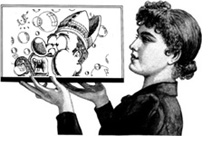
On the Power, Misuse & Neglect of Liturgical Symbolism
"THIS IS MY BODY" OR "HAVE A NICE DAY"?
“The institution that understands the power of symbols best is the Catholic Church.” This statement, which I heard over thirty years ago in a sociology class in an Ivy League college, seemed remarkable at the time. The professor making it was Jewish — and it was greeted with good-natured hisses by the students — mostly cradle-Protestants who presumably saw the Church as an instrument of oppression amid Age of Aquarius liberation. The statement remained in my mind, and it seems worth revisiting now, decades later. For I wonder if it could be made today. In their apparently unending efforts to make the Church “relevant” to the “modern” world, her shepherds in recent years have been showing a diminished understanding of how the Church’s traditional symbols speak to the heart of the human condition, and they have often traded the power of liturgical symbols for what at some times seems nothing more than poorly followed rules of procedure for a town meeting, and for what at other times is nothing at all. The impoverishment of Catholic symbols has led to a desacralization of Catholic life.
The most serious example is also the most laden with irony: The diminution of symbols has notably detracted from the meaning of what is far more than a symbol — namely, the Real Presence in the Eucharist. Recently the cardinal archbishop of an east coast archdiocese expressed his chagrin upon learning that most Catholics in the U.S. either do not understand or do not believe in the Real Presence. The cardinal, however, acknowledged no responsibility for the role he and his fellow bishops have played in overseeing the degradation and elimination of certain liturgical symbols (and the addition of others) that have promoted this condition of ignorance and disbelief. There is a serious relationship between belief in the Eucharist and the symbolic messages communicated in the course of its celebration. And those messages are communicated — not unlike the messages sent by the set and costumed actors on a theater stage — primarily in and from the sanctuary.
Not so long ago, the only people in the sanctuary at Sunday Mass were the priest and the altar boys and, at the rare Solemn High Mass, two other priests functioning as deacons. The focus on the most important action taking place there — the Eucharist — was clear. Today, however, priests are also joined in the sanctuary on Sunday and even weekdays by the choir, lectors, and Eucharistic ministers. The new symbolism now is similarly but misguidedly powerful: The functions performed by each “minister” can be easily if mistakenly seen as equally important. The presence of Christ in the Eucharist consecrated by an ordained priest, then, is readily if wrongly viewed as no different from His presence in the words read or in the songs sung by laity.
The effects of the misuse of other symbols surrounding the Eucharist are even more direct and deleterious: the absence or removal of communion rails; reception of the Eucharist while standing rather than kneeling; Communion-in-the-hand; the distraction of the horribly misplaced Sign of Peace; the regular use of lay Eucharistic ministers even when communicants are few; the moving of the Tabernacle, in even the smallest churches, away from a central location; the virtual disappearance of Benediction of the Blessed Sacrament; the reduction of the altar to about the size of a card table. The theology justifying all these practices might be legitimate, but to the 99.44 percent of God’s pure people not theologically schooled, a definite — perhaps unintended — message has been communicated about the meaning (or lack thereof) of the Eucharist.
You May Also Enjoy
Difficulties arise when women wear tight or revealing pants to Church: Men start seeing them as a collection of titillating body parts.
If a Catholic church building doesn't reflect Catholic theology, the worshiper risks accepting a faith that is foreign to Catholicism.
The lack of a stable liturgical model from some golden age does not mean that the things of every culture and age are equally suitable for solemn liturgy.

